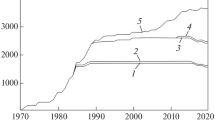Abstract—
With a growth in the scales on which binary cycle (ORC) power units are constructed, new technical solutions aimed at improving the efficiency of binary technologies are searched for. To this end, the possibility of using multistage ORCs based on the principle of incremental (staged) conversion of geothermal fluid energy is also studied. In view of the fact that low-temperature geothermal resources dominate around the world (the fluid outlet temperature is lower than 130°С in up to 60% of all geothermal fields), the optimization calculated studies of two- and three-stage ORCs were carried out for a source geothermal fluid with a temperature of 120°С. The article presents the results of studying the effect that the choice of low-boiling organic substances and the geothermal fluid temperature in the stages have on achieving the cycle maximal power output and minimal fluid mass flowrate. The technical characteristics of two- and three-stage ORCs are compared with those of a conventional single-loop ORC power unit in the case of using various nontoxic and fire- and explosion-safe organic substances. It is shown that, by applying a three-stage process circuit with R-600 working fluid in all loops and using geothermal fluid with a temperature of 120°С, it is possible to increase the amount of heat transferred to the binary cycle by 36.5% in comparison with the single-stage process circuit. In accordance with the previously performed calculations, the growth of heat transferred to the binary cycle in the case of using geothermal fluid with a temperature of 180°С amounted to 15.0%. It has been found that the minimal (net and gross) mass flowrates of geothermal fluid with a temperature of 120°С in the three-stage process circuit are achieved in the case of using R-600 substance as working fluid in the first, second, and third stages and make 44.6 and 42.7 (kg/s)/MW, respectively. The obtained results can be used in the development and designing of multistage ORCs with the geothermal fluid temperature equal to 120°С.










Similar content being viewed by others
REFERENCES
Z. Gnutek and A. Bryszewska-Mazurek, “The thermodynamic analysis of multicycle ORC engine,” Energy 26, 1075–1082 (2001). https://doi.org/10.1016/S0360-5442(01)00070-6
F. Heberle, T. Jahrfeld, and D. Brüggemann, “Thermodynamic analysis of double-stage Organic Rankine Cycles for low-enthalpy sources based on a case study for 5.5 MWe power plant Kirchstockach (Germany),” in Proc. World Geothermal Congr., Melbourne, Australia, Apr. 19–24, 2015 (International Geothermal Association, Melbourne, 2015).
G. V. Tomarov and A. A. Shipkov, “Multistage geothermal ORC power units: Utilization of high-temperature (180°C) Geothermal Fluid,” Therm. Eng. 69, 259–266 (2022).
G. V. Tomarov and A. A. Shipkov, “A combined binary-cycle geothermal power plant with a secondary flash steam superheating system: Choice of optimal working fluids,” Therm. Eng. 66, 822–829 (2019). https://doi.org/10.1134/S0040601519110065
R. DiPippo, Geothermal Power Plants. Principles, Applications, Case Studies and Environmental Impact, 4th ed. (Elsevier, 2015). https://doi.org/10.1016/C2014-0-02885-7
V. A. Butuzov and G. V. Tomarov, “Geothermal energy of Kamchatka,” Therm. Eng. 67, 820–832 (2020). https://doi.org/10.1134/S004060152011004X
G. V. Tomarov and A. A. Shipkov, “Modern geothermal power: Binary cycle geothermal power plants,” Therm. Eng. 64, 243–250 (2017). https://doi.org/10.1134/S0040601517040097
M. Mahmoud, M. Ramadan, S. Naher, K. Pullen, M. A. Abdelkareem, and A.-G. Olabi, “A review of geothermal energy-driven hydrogen production systems,” Therm. Sci. Eng. Prog. 22, 100854 (2021). https://doi.org/10.1016/j.tsep.2021.100854
Y. G. Yohanis, O. S. Popel, and S. E. Frid, “A simplified method of calculating heat flow through a two-phase heat exchanger,” Appl. Therm. Eng. 25, 2321–2329 (2005). https://doi.org/10.1016/j.applthermaleng.2004.12.011
Geothermal Binary Power Plants. Preliminary Study of Low Temperature Utilization, Cost Estimates and Energy Cost (Verkis Consulting Engineers, Reykjavik, Iceland, 2014).
Author information
Authors and Affiliations
Corresponding authors
Ethics declarations
The authors declare that they have no conflicts of interest.
Additional information
Translated by V. Filatov
See our article published in Thermal Engineering, 69, 259–266 (2022).
Rights and permissions
About this article
Cite this article
Tomarov, G.V., Shipkov, A.A. Multistage Organic Rankine Cycles: Utilization of Medium Temperature (120°С) Geothermal Fluid. Therm. Eng. 69, 354–361 (2022). https://doi.org/10.1134/S0040601522050068
Received:
Revised:
Accepted:
Published:
Issue Date:
DOI: https://doi.org/10.1134/S0040601522050068




